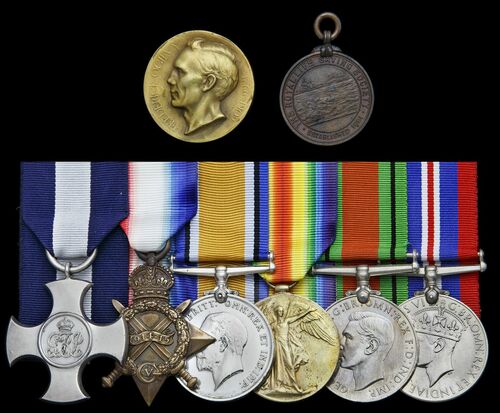
Auction: 24001 - Orders, Decorations and Medals
Lot: 125
A 'Light Cruiser Squadron' D.S.C. group of six awarded to Captain W. P. Stocker, Royal Navy, a veteran of Jutland, Heligoland Bight and Operation Red Treck who was also awarded the Ogilvy Medal in 1917
Distinguished Service Cross, G.V.R., hallmarks for London 1919; 1914-15 Star (Lieut. W. P. Stoker, R.N.); British War and Victory Medals (Lieut. W. P. Stocker, R.N.); Defence and War Medal 1939-45, together with the Ogilvy Medal, in gold, 39m.m., (Lieutenant William Pennell Stocker, R.N.), in its fitted case of issue, and his Royal Life Saving Society Medal, in bronze, the reverse inscribed, ‘W. P. Stocker, Mar. 1903’, light pitting, very fine (6)
Provenace:
D.N.W. September 2012, ex-RC Witte collection.
D.S.C. London Gazette 27 June 1919, the original citation states:
'For distinguished services in H.M.S. Galatea, 1st Light Cruiser Squadron, and H.M.S. Cardiff, 6th Light Cruiser Squadron.’
William Pennell Stocker was born at London on 5 August 1892, the son of an architect and surveyor William Stocker and his wife Laura. Joining the Royal Navy as a cadet in May 1905 with the training establishment he was appointed Midshipman on 15 January 1910 with Superb. Joining Bristol the next year, on 14 January, Stocker was recorded there upon the 1911 census when the ship was on station at Bristolport.
Commissioned Sub-Lieutenant aboard Achilles on 15 January 1915 he was further advanced Lieutenant aboard Royal Arthur on 15 April 1914. He was still with this vessel on the outbreak of the Great War, being posted ashore in November 1914 and thence to Galatea on 30 March 1915. This light cruiser was stationed as leader of the 2nd Destroyer Flotilla at the time as part of Harwich Force.
L7
She was in on the action off Horns Rev, Denmark on 7 April when the along with Phaeton and the submarine E-31 she brought down L7. The two cruisers fired upon the zeppelin as she dived towards E31, the submarine meanwhile, seeing the shots had good effect surfaced and finished the job. Galatea later joined the 1st Light Cruiser Squadron as flagship and its was in this role that she was to serve in the Battle of Jutland.
Jutland
While scouting ahead of the Battlecruiser Fleet Galateawas the first British vessel to spot the Germans and the first to fire a shot. Somewhat ominously she was also to be the first ship to take a hit, being struck by a shell from Elbing just beneath her bridge which fortunately did not detonate. Participing in both Runs to the South and the North she was damaged by a shell splinter which knocked out a forced-draught fan. This had the effect of seriously reducing the ships speed to only 18 knots, preventing her from playing much more of a role in the Battle. She did however go to the rescue of the damaged Acasta although the offer of help was declined.
After the action Stocker was posted ashore where he joined the Torpedo School H.M.S. Vernon. Proving to be the course's top candidate he was awarded the Ogilvy Medal for 1917. On completing the course he removed to the light cruiser Cardiff, joining her in August 1917 and seeing action at the Second Battle of Heligoland Bight on 17 November. Here she took a number of hits, on the forecastle, torpedo department and on the superstructure.
Red Trek
The end of the war in Europe saw Cardiff given the honour of escorting the German High Seas fleet into the Firth of Forth on 18 November 1918. After which she was posted to the Baltic as part of Operation Red Trek, the British response to the Bolshevik invasion of Estonia and Latvia. Cardiff and her sister ship Caradoc were instrumental in turning back Russian troops east of Tallinn. They were later also involved in destroying a bridge connecting the Russians in Estonia with reinforcements from Petrograd, this proved key to halting their advance.
Posted back to Vernon in March 1920 Stocker was posted to join the British Naval Mission to Greece, headed by Admiral Kelly, the next year and was promoted Lieutenant-Commander while there on 15 April 1922. Further advanced Commander on 30 June 1927 he was placed on the retired list as a Captain on 30 January 1939.
Torpedo Expert
Returning to Service on the outbreak of the Second World War Stocker was posted to President in London for duty with the Admiralty on 1 February 1940. Later he removed to Bath where his expertise where utilised under the Director of Torpedoes and Mining. A report from this time states that he had 'worked hard and loyally for many years on the technical aspects of torpedoes' which provides some clue as to his role. Stocker was finally returned to the retired list on 5 December 1945 ; sold together with a letter from the recipient's brother-in-law regarding the Ogilvy medal as well as copied research including a London Gazette extract and service papers.
Subject to 20% VAT on Buyer’s Premium. For more information please view Terms and Conditions for Buyers.
Sold for
£1,900
Starting price
£1800




